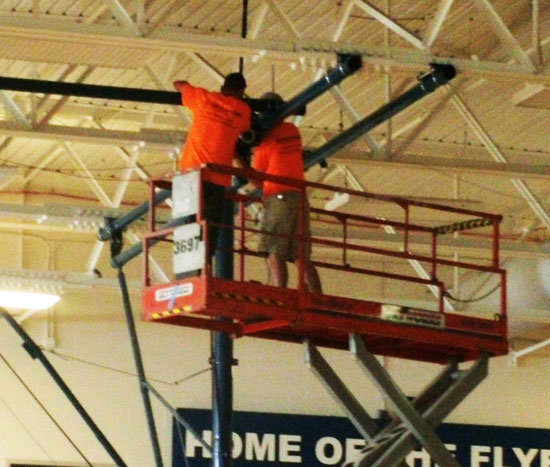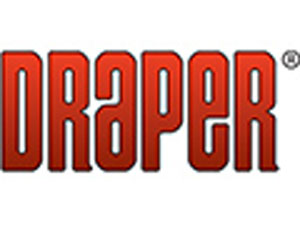Safety in the Gym: Specifying Equipment to Protect Users and Spectators
Scoreboard Fitting
In some gymnasiums, heavy scoreboards may need to be lowered or raised to change signage, perform routine service and maintenance, or make repairs. This eliminates the need to set up scaffolding or use potentially dangerous lifts or ladders. Depending on the manufacturer, systems can be designed and built that can handle very large scoreboards. All systems should include a properly sized, heavy-duty winch and one or more cable drum assemblies with safety locks.

Photo courtesy of Draper, Inc.
Gymnasium equipment that rises and lowers with the help of winches eliminates the need for the use of hyraulic lifts.
Routine and Preventative Maintenance
Gymnasium equipment is mechanical equipment. Much like an automobile or any other mechanical device, it needs to be maintained to ensure its continued safety.
It’s important to remember that this equipment is heavy and hangs above people’s heads.
Equipment should be inspected and serviced by a qualified individual at least once per year. This person needs to have a good understanding of how backboards, dividers, and other types of gym equipment work, and how they attach to the building.
The person doing the inspection and service should have a checklist, usually from a manufacturer, that shows what items need to checked so they have something to guide them.
Service may be necessary more often in high-use facilities. Inspection and service should be taken seriously and not put off.
Green Certifications for Gymnasium Equipment
The vinyl used for gym divider curtains—like all vinyl materials—can emit chemical compounds, known as volatile organic compounds (VOCs), as can the vinyl, foam, and glue used to make wall padding. This can be a significant risk in a gymnasium, as excessive or certain VOCs can trigger asthma attacks or allergic reactions for some gym users. Children in particular are most affected by breathing VOCs.
Ideally, divider curtains and wall padding are certified UL GREENGUARD Gold, which is a rigorous certification and was formerly known as GREENGUARD for Children and Schools. Wall pads should be tested as a complete unit—not just the vinyl—since the glue and padding can also emit VOCs.
Conclusion
Gymnasium safety is typically taken for granted when it is specified, installed, operated, and maintained properly. However, when it is not up to industry or required standards, injuries and even fatal accidents can occur. Those accidents capture headlines and often bring about wide-ranging, complicated lawsuits. Therefore, the designer, architect, or specifier should understand the dangers inside a gymnasium and how to prevent injuries caused by ineffective, insufficient, or failed safety equipment.
Gymnasiums are inherently complicated and somewhat dangerous environments. Safety considerations include basketball backstops, winches to move backstops out of the way, the problem of shattering backboards, and the importance of padding on the bottom edge of backboards to prevent injury to players’ heads.
Divider curtains have an important safety function in gyms. Critical issues include where the curtains are placed, how they are operated, and the winches and other equipment involved.
Practice and batting cages need special consideration on account of high-velocity balls and athletes that can hurt players and others. Winches and safety straps play a part. In all cases of equipment operation, strategies should be used to ensure no one other than the official operator has access to controls. This could include a key, a password, or other strategies.
While wall pads will not prevent all injuries, for safety purposes the lack of wall padding, or insufficient wall padding, can place gym users in danger of injury, permanent disability, or even death. The wall padding is important, as is sufficient distance between the boundaries of a court and the wall. Ideally, according to industry standards, there is a 10-foot gap.
Fire safety should be considered, as well the use of non-toxic building materials that do not emit VOCs.
Other safety equipment and considerations include volleyball equipment, wrestling mat lifters, scoreboard lifting, and routine maintenance.
For the architect, designer, or specifier of a gym, safety issues should ideally never show up in a newspaper headline. With knowledge of gym safety, savvy specification, and maintenance of equipment, both athletes and spectators can use the gym with the expectation of personal safety they do, and should, expect.

|
Draper, Inc. is a Spiceland, Indiana-based manufacturer of gymnasium equipment, window coverings, and audio visual equipment. As one of the largest manufacturers of gym equipment in North America, Draper builds custom solutions for gyms of all sizes and types. www.draperinc.com |








